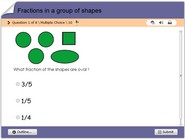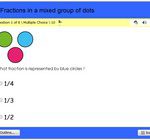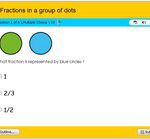Fractions in a group of shapes quiz
Fractions in a group of shapes quiz Online. Learn fractions with shapes.
Fractions in a group of mathematical shapes interactive quiz online
Fractions in a group of mathematical shapes interactive quiz online. This quiz will be a great way to test children in 1st, 2nd and 3rd grades on their skills in fractions. It takes the form of a multiple choice quiz with different answers to choose from. Children will solve a problem and select the correct answer. This makes this quiz a great self-test for classroom and homeschool use. This game is in line with common core state stands. It can be taken for free and repetitively.
Learning fractions can be a challenging concept for many students, but teaching fractions using shapes can be a helpful visual aid. Using shapes to teach fractions allows students to see the concept in a concrete way, which can make the abstract concept of fractions more accessible.
One way to introduce fractions using shapes is to begin with a whole shape, such as a circle or square. You can then divide the shape into equal parts, labeling each part as a fraction. For example, if you divide a circle into halves, you can label each half as 1/2. If you divide the same circle into quarters, you can label each quarter as 1/4.
Another way to teach fractions using shapes is to have students create their own fractions using manipulatives, such as pattern blocks or geoboards. For example, a student could use pattern blocks to create a rectangle and then divide it into halves, labeling each half as 1/2. They could also divide the rectangle into thirds, labeling each third as 1/3.
In addition to using manipulatives, you can also use worksheets or online activities to help students practice identifying and creating fractions. These activities can include identifying the fraction that represents a given part of a shape, as well as creating their own fractions by dividing shapes into equal parts.
It’s also important to introduce students to mixed numbers and improper fractions. A mixed number is a fraction that includes a whole number, such as 3 1/2. An improper fraction is a fraction where the numerator (the top number) is larger than the denominator (the bottom number), such as 7/4. By introducing these concepts, students will have a more complete understanding of fractions and how they work.
One way to help students understand mixed numbers and improper fractions is to use a number line. A number line can show students that fractions are just parts of a whole, and that mixed numbers and improper fractions can be represented as points on a number line.
In addition to using a number line, you can also use real-life examples to help students understand fractions. For example, you can ask students to divide a pizza into equal parts and label each part as a fraction. This can help students see that fractions can be used to represent real-life situations, such as sharing food or other resources.
Overall, using shapes to teach fractions can be an effective way to help students understand this challenging concept. By using manipulative, worksheets, online activities, and real-life examples, students can see the concept of fractions in a concrete way, which can make it easier for them to understand and apply this important math skill.



